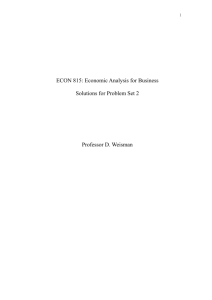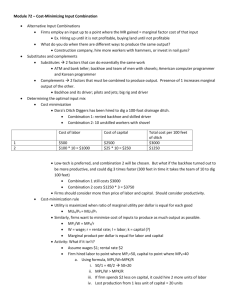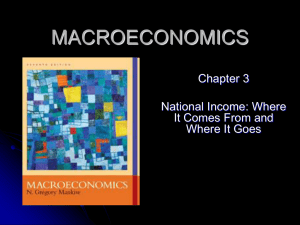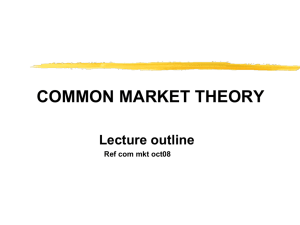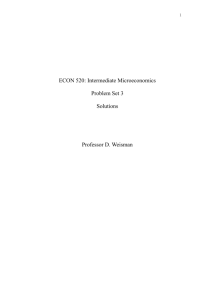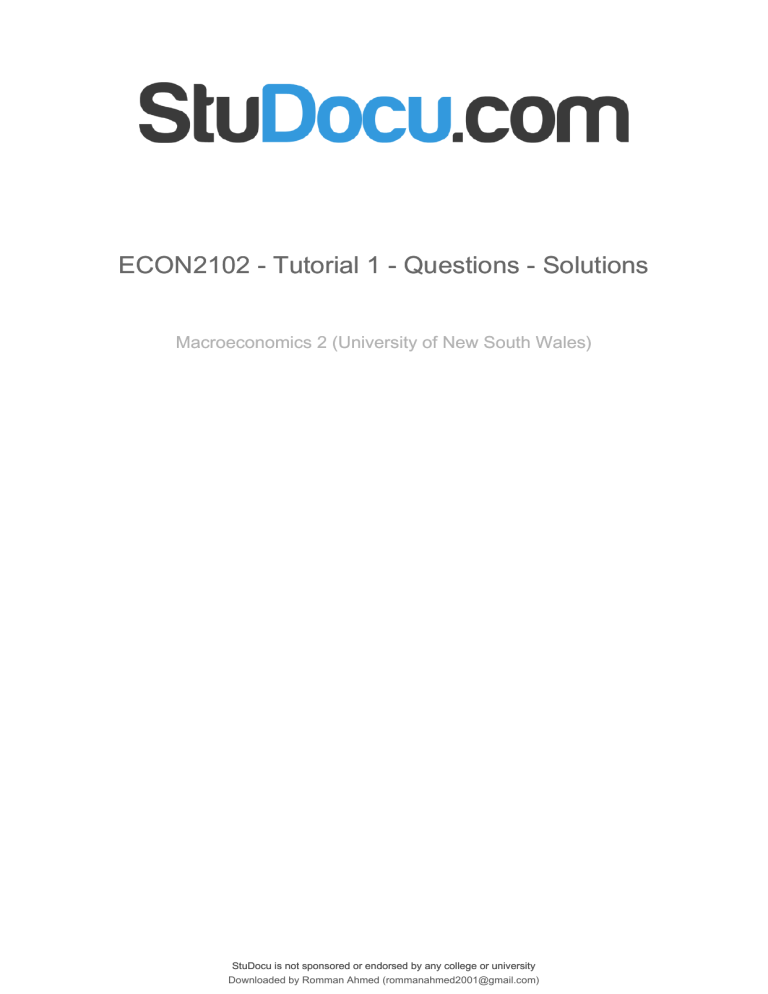
lOMoARcPSD|3421444 ECON2102 - Tutorial 1 - Questions - Solutions Macroeconomics 2 (University of New South Wales) StuDocu is not sponsored or endorsed by any college or university Downloaded by Romman Ahmed (rommanahmed2001@gmail.com) lOMoARcPSD|3421444 ECON2102 – Tutorial 1 – Questions Why Doesn’t Capital Flow from Rich to Poor Countries? Human Capital: our textbook points out that human capital is not included in the simple model of production but that it could be an important factor in explaining why the marginal product of capital differs among countries. 1) Consider a Cobb-Douglas production function with three inputs: 𝑌𝑌 = 𝐾𝐾 1/3 𝐿𝐿1/3 𝐻𝐻1/3 Where K represents capital, L represents labour and H represents human capital. What is the marginal product of capital (MPK) implied by this production function? Also, find the expression for the marginal product of labour (MPL). What would a typical firm be inclined to do if the MPL was lower than the real wage? The MPK implied is: 𝑀𝑀𝑀𝑀𝐾𝐾 = 𝜕𝜕𝑌𝑌 1 −2/3 1/3 1/3 = 𝐾𝐾 𝐿𝐿 𝐻𝐻 𝜕𝜕𝐾𝐾 3 𝑀𝑀𝑀𝑀𝐿𝐿 = 𝜕𝜕𝑌𝑌 1 1/3 −2/3 1/3 = 𝐾𝐾 𝐿𝐿 𝐻𝐻 𝜕𝜕𝐿𝐿 3 Notice how this expression is positive, implying that the more capital is added in the economy the higher output will be. The expression for the MPL is: Same implications as the ones in the case above. A firm facing MPL < w would be tempted to lay off some of its workers because the contribution brought about by an extra person (MPL) is lower than what the firm is compensating them (w). Alternatively, if a firm lay off one extra worker, the gains in terms of lower costs (w) will be larger than the loss in terms of production (MPL). 2) Use your results in part 1 to illustrate the notion of diminishing returns to capital. [Hint: you will need to find the second derivative of output with respect to capital and show it is negative]. Using the hint: 𝜕𝜕𝑌𝑌 2 𝜕𝜕𝑀𝑀𝑀𝑀𝐾𝐾 2 −5 1 1 = = − 𝐾𝐾 3 𝐿𝐿3 𝐻𝐻 3 𝜕𝜕 2 𝐾𝐾 𝜕𝜕𝐾𝐾 9 This expression is clearly negative as the stock of capital, labour and human capital are positive. This result implies that the more capital is added to the economy the smaller the increases in output. Graphically, this implies the production function (on a Y-K plane) will be concave (the shape explored in lectures and tutorials). Downloaded by Romman Ahmed (rommanahmed2001@gmail.com) lOMoARcPSD|3421444 3) Is the MPK increasing or decreasing in human capital? I.e., does the MPK increase or decrease when H increases? No need to use a second derivative, just a brief explanation suffices. We can clearly from the MPK derived in part 1 that the higher H the higher K will be, ceteris paribus. Some students might be tempted to use calculus here to illustrate this point: 1 2 1 2 𝜕𝜕 2 𝑌𝑌 = 𝐾𝐾 −3 𝐿𝐿3 𝐻𝐻 −3 > 0 𝜕𝜕𝐾𝐾𝜕𝜕𝐻𝐻 9 4) Use this model to explain why capital may flow from poor to rich countries. Capital would flow from the country with smaller MPK to the one with higher. In a model without human capital, this would mean poorer countries (with higher MPK) would receive flows from the rich. But this doesn’t have to be the case if the model accommodates for other factors of production. A country with higher MPK can be the rich one because it has a higher level of human capital. For example, assume the rich and poor country have the same labour force and stock of capital, but the rich country has a higher level of human capital. Therefore, 𝐻𝐻𝑅𝑅𝑅𝑅𝑅𝑅ℎ > 𝐻𝐻𝑃𝑃𝑃𝑃𝑃𝑃𝑃𝑃 1/3 1/3 𝐻𝐻𝑅𝑅𝑅𝑅𝑅𝑅ℎ > 𝐻𝐻𝑃𝑃𝑃𝑃𝑃𝑃𝑃𝑃 1 2 1 1/3 1 −2 1 1/3 𝐾𝐾 3 𝐿𝐿3 𝐻𝐻𝑅𝑅𝑅𝑅𝑅𝑅ℎ > 𝐾𝐾 −3 𝐿𝐿3 𝐻𝐻𝑃𝑃𝑃𝑃𝑃𝑃𝑃𝑃 3 3 𝑀𝑀𝑀𝑀𝐾𝐾𝑅𝑅𝑅𝑅𝑅𝑅ℎ > 𝑀𝑀𝑀𝑀𝐾𝐾𝑃𝑃𝑃𝑃𝑃𝑃𝑃𝑃 So, capital would naturally flow from the poor to the rich, contradicting the conclusion of convergence suggested in the Solow-Swan model. Intuitively, capital is more productive when operated by labour with higher education, so it makes sense that firms would be more inclined to produce (and send their capital to) countries with more capable labour force. 5) Is the return to education (MPH) higher or lower in countries with scarce capital? The return to education is: 𝑀𝑀𝑀𝑀𝐻𝐻 = 𝜕𝜕𝑌𝑌 1 1/3 1/3 −2/3 = 𝐾𝐾 𝐿𝐿 𝐻𝐻 𝜕𝜕𝐻𝐻 3 It increases with K, so poorer countries (scarce capital) have a lower return to education in relation to richer countries. This is symmetric to the situation in part 4. Downloaded by Romman Ahmed (rommanahmed2001@gmail.com)
